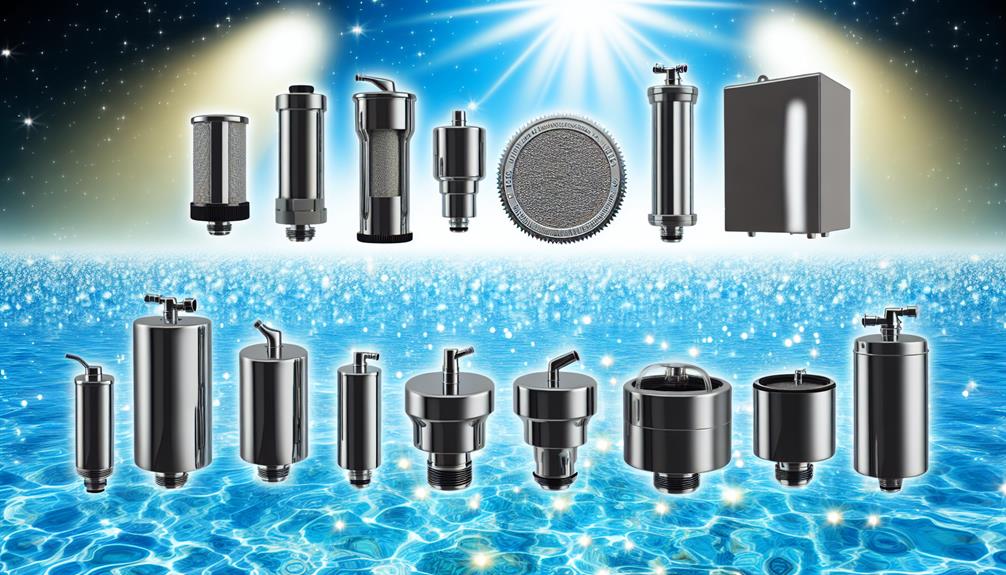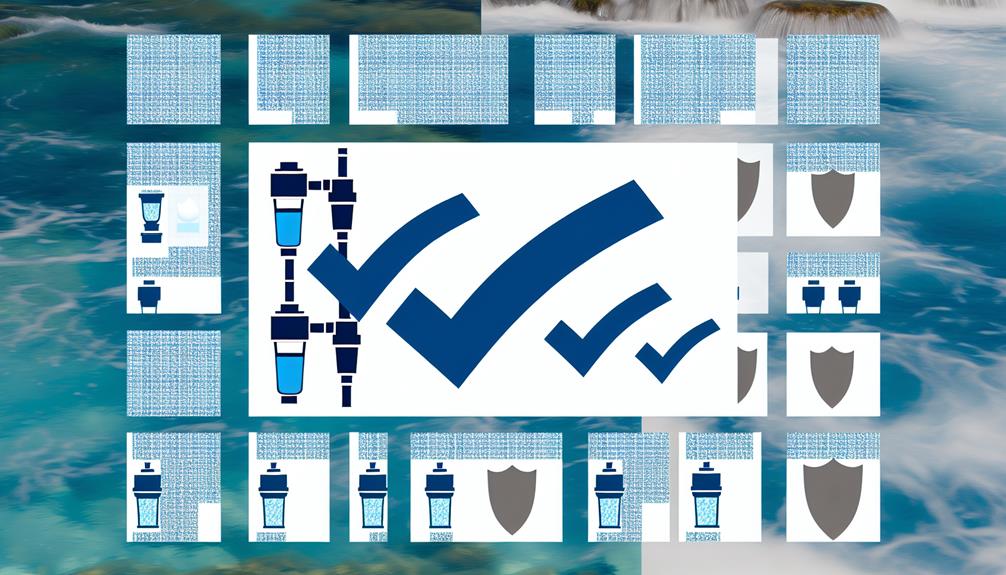Imagine a world where every drop of water from your faucet is as pure as the fountain of youth—that's the promise of the latest health-compliant water filtration systems. You're on a quest to provide the safest, cleanest water for your household, and it's no small feat given the myriad of contaminants that can lurk in unfiltered tap water.
Whether it's lead, chlorine, or other invisible adversaries, the right filtration system can seem like a knight in shining armor for your health and well-being. In the following discussion, you'll find an exploration of six state-of-the-art systems, each with their own unique arsenal to combat impurities. From the cutting-edge technology of reverse osmosis to the steadfast protection offered by multi-stage units, you're about to uncover the layers of defense these systems provide.
But which one will emerge as the champion of purity in your home? Stay tuned as we unveil the contenders that promise to transform your water into a bastion of health.
NSF-Certified Filter Overview
When you choose an NSF-certified filter, you're selecting a water filtration system that has met rigorous safety and performance standards set by the National Sanitation Foundation. This NSF-certified filter overview will help you understand the technical aspects and benefits of such systems.
Recognized by the Water Quality Association (WQA), these filters are certified to remove a variety of contaminants. For instance, a reverse osmosis water filter, which often holds NSF certification, is known to strip water of pollutants, including chlorine, heavy metals, cysts, herbicides, and pesticides.
NSF certification assures you that the water filtration system isn't only effective at removing contaminants but also complies with stringent health standards and regulations. These systems are tested to confirm they remove dozens of contaminants, ensuring your water is safe for consumption. Moreover, many of these filters employ activated carbon, which is instrumental in reducing unwanted tastes and odors.
There are different types of filters within the NSF-certified range, including those designed to tackle specific issues such as PFOA and PFOS. By choosing an NSF-certified product, you're investing in a high-quality water filtration system that upholds your health and safety as a priority.
Lead Removal System Highlights
Efficiently safeguarding your drinking water, lead removal systems are specifically engineered to reduce lead contamination, thereby addressing the significant health risks linked to its presence in your water supply. When you're considering a water filter system, the lead removal system highlights are crucial for ensuring the safety and quality of your tap water.
These systems utilize advanced filtration technology to effectively remove not only lead but also other heavy metals that may be lurking in your water.
To ensure you're getting a system that's certified for lead removal, always check the Consumer Confidence Report for your area and compare it with the filter's test results. This will confirm that the filters tested are up to the task of purifying your water.
It's imperative to have your water tested as well, to understand the specific contaminants you're dealing with.
Reverse Osmosis Filtration Insights
You'll find that reverse osmosis filtration hinges on a semi-permeable membrane's ability to block contaminants while allowing water molecules to pass through. Assessing the efficiency of contaminant removal is crucial, as these systems vary in their ability to filter out different types and sizes of impurities.
Consider the ongoing maintenance and associated costs, as these factors are integral to the system's long-term performance and your overall investment.
How Reverse Osmosis Works
Reverse osmosis filtration harnesses pressure to push water through a semi-permeable membrane, effectively sieving out a spectrum of contaminants from heavy metals to dissolved solids. This process ensures you're getting filtered water that's free from harmful contaminants, contributing to safe drinking water for you and your family.
- Pressure Application: Uses water pressure to move water molecules through the membrane.
- Contaminant Removal: Effectively remove contaminants, including those identified by the Environmental Working Group.
- Post-Filtration: Includes a post-filter for additional water polishing.
- Maintenance Required: Regular filter replacement is crucial to maintain filter life.
- Professional Installation: Ensures the system operates efficiently and effectively.
Contaminant Removal Efficiency
When considering the efficacy of reverse osmosis systems, it's essential to note that these units can eliminate up to 99% of total dissolved solids, making them highly effective in purifying your drinking water.
Unlike standard filter pitchers, advanced reverse osmosis technologies, such as the Elite Filter, incorporate several stages of removing filters, including a semi-permeable membrane and a carbon filter.
This multi-stage process ensures a broad range of contaminants, from Volatile Organic Compounds (VOCs) to Forever Chemicals, are efficiently stripped from your water.
The precision of reverse osmosis in targeting both inorganic and organic compounds surpasses conventional methods, providing protection against harmful chemicals present in various types of water.
Therefore, for health-conscious individuals, investing in a reverse osmosis system is a sound decision for ensuring water quality and safety.
Maintenance and Cost Considerations
While reverse osmosis systems are highly effective in purifying water, they do necessitate regular maintenance, including filter replacements approximately every six months, to maintain their performance. When considering the ease of use and filter lifespan, it's crucial to evaluate both the initial investment and the ongoing costs.
Here are some key points to consider:
- Replacement filters: Typically required bi-annually with a price per filter that can average between $50 and $80 yearly.
- Cartridge replacement: Necessary to ensure a consistent flow rate and water quality.
- Testing water: Regular testing can indicate the need for replacing filters.
- Ease of use: Systems should be user-friendly to encourage timely maintenance.
- Refill the pitcher: Not applicable to reverse osmosis systems, but a reminder of the simplicity some consumers prefer.
Analyzing these factors will help you grasp the total cost of ownership for a reverse osmosis system.
Multi-Stage Purification Breakdown
Multi-Stage Purification Breakdown utilizes a series of targeted filters to systematically remove contaminants like chlorine, heavy metals, and organic compounds, ensuring your water is safe and pure for drinking. This water filter technology is engineered to tackle a variety of pollutants through its comprehensive design. As your water system processes the inflow, each stage is tested and optimized to address specific impurities.
The initial stage often consists of a sediment filter that captures larger particles. Subsequent filters remove smaller contaminants; these can include activated carbon filters for organic chemicals and chlorine, as well as ion-exchange filters for metals like lead. A pivotal feature in some systems is the inclusion of UV light, which neutralizes bacteria and viruses that may elude other filters.
In a multi-stage purification breakdown, the combination of these filters is critical. Pitcher filters and faucet filters may incorporate two or three filters, but a more advanced water system will include several stages. Each stage is tailored to eliminate different types of contaminants, resulting in a thorough purification process.
Activated Carbon Filter Features
You'll find that activated carbon filters rely on a process called adsorption to trap contaminants, effectively purifying your water.
These systems are designed for ease of use, with a maintenance schedule that typically involves a semi-annual filter change.
Understanding the technical aspects of their operation and lifespan ensures you can maintain the quality of your drinking water with minimal effort.
Adsorption Process Explained
Activated carbon filters harness the power of adsorption to efficiently remove contaminants from water by attracting and trapping impurities onto their expansive surface area. This process is key to delivering clean water to your glass. Whether you're using a water pitcher, such as a Brita filter, or a faucet-mounted system like Pur Plus, the underlying mechanism is the same.
Here's how the adsorption process works in the context of filtering water:
- Vast Surface Area: The carbon granules provide a large area for adsorption.
- Targeted Contaminants: Chlorine, VOCs, and other organics are effectively removed.
- Taste and Odor: Bad tastes and odors are significantly reduced.
- Health Benefits: Reduces potential risks associated with consuming unfiltered water.
- Water Quality: Overall water quality is improved by removing impurities.
Understanding the adsorption process explained here ensures you're informed about the health benefits and the importance of using water filters.
Maintenance and Lifespan
Ensuring your water remains pure is essential to preserve its taste and safety. Regular maintenance of activated carbon filters is necessary to trap contaminants effectively. Typically, these filters require maintenance every six months. It is important to consistently check the filters to prevent clogging, as this can diminish their capacity to improve the quality of your drinking water.
Heeding the replacement schedule is crucial. Promptly replacing the filter will help maintain its optimal performance. A well-maintained filter means you'll be refilling your water reservoir less often. This is because a clean filter ensures that the water doesn't deplete rapidly due to inefficiency.
How much water you use and its initial quality will determine how often you'll need to refill your reservoir and ultimately affect how long your filter will last. By adhering to these guidelines, you can make your activated carbon filter last longer. This guarantees a steadfast defense against impurities and ensures that you have access to clean and safe drinking water.
UV Disinfection System Advantages
Harnessing the power of ultraviolet light, UV disinfection systems provide an efficient and non-chemical method to eliminate harmful microorganisms in water. As you consider a water filter for your home water needs, it's crucial to understand the UV Disinfection System Advantages. These systems are a significant addition to any water purification process, ensuring that your tap water is safe for consumption.
- Chemical-Free: Unlike traditional methods, UV systems don't introduce chemicals into your water, maintaining its natural taste and preventing potential health risks associated with chemical use.
- Effective Against Resistant Pathogens: These systems can inactivate chlorine-resistant microorganisms, which may be present in your sink water and aren't always filtered out by conventional methods.
- Minimal Maintenance: UV systems require less upkeep compared to other filters, as there are no filters to change frequently, saving you time and effort.
- Eco-Friendly: They don't produce harmful by-products or waste, making them a greener choice for water disinfection.
- Consistent Water Pressure: UV systems allow water to pass through the filter without a significant drop in water pressure, ensuring a steady flow at your fixtures.

